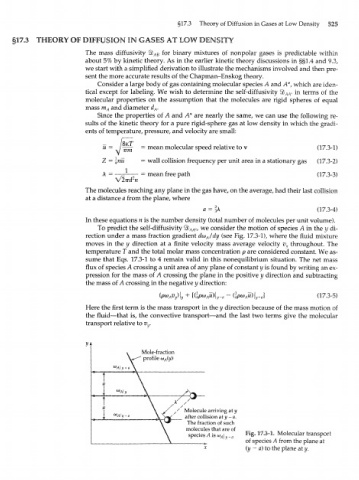Page 545 - Bird R.B. Transport phenomena
P. 545
§17.3 Theory of Diffusion in Gases at Low Density 525
§17.3 THEORY OF DIFFUSION IN GASES AT LOW DENSITY
The mass diffusivity Яй АВ for binary mixtures of nonpolar gases is predictable within
about 5% by kinetic theory. As in the earlier kinetic theory discussions in §§1.4 and 9.3,
we start with a simplified derivation to illustrate the mechanisms involved and then pre-
sent the more accurate results of the Chapman-Enskog theory.
Consider a large body of gas containing molecular species A and A*, which are iden-
tical except for labeling. We wish to determine the self-diffusivity % * in terms of the
AA
molecular properties on the assumption that the molecules are rigid spheres of equal
mass m A and diameter d .
A
Since the properties of A and A* are nearly the same, we can use the following re-
sults of the kinetic theory for a pure rigid-sphere gas at low density in which the gradi-
ents of temperature, pressure, and velocity are small:
и = = mean molecular speed relative to v (17.3-1)
Z = - nu = wall collision frequency per unit area in a stationary gas (17.3-2)
A
1
A = = mean free path (17.3-3)
2
V2ird n
The molecules reaching any plane in the gas have, on the average, had their last collision
at a distance a from the plane, where
a = \k (17.3-4)
In these equations n is the number density (total number of molecules per unit volume).
To predict the self-diffusivity ^ *, w e consider the motion of species A in the у di-
AA
rection under a mass fraction gradient dco /dy (see Fig. 17.3-1), where the fluid mixture
A
moves in the у direction at a finite velocity mass average velocity v throughout. The
y
temperature T and the total molar mass concentration p are considered constant. We as-
sume that Eqs. 17.3-1 to 4 remain valid in this nonequilibrium situation. The net mass
flux of species A crossing a unit area of any plane of constant у is found by writing an ex-
pression for the mass of A crossing the plane in the positive у direction and subtracting
the mass of A crossing in the negative у direction:
y y y | J (173-5)
y +
Here the first term is the mass transport in the у direction because of the mass motion of
the fluid—that is, the convective transport—and the last two terms give the molecular
transport relative to v .
y
Mole-fraction
profile ш (у)
А
Molecule arriving at у
after collision at у - a.
The fraction of such
molecules that are of Fi
species Aisa, \ _ §» ^73-1. Molecular transport
A y a
of species A from the plane at
(y - a) to the plane at y.

